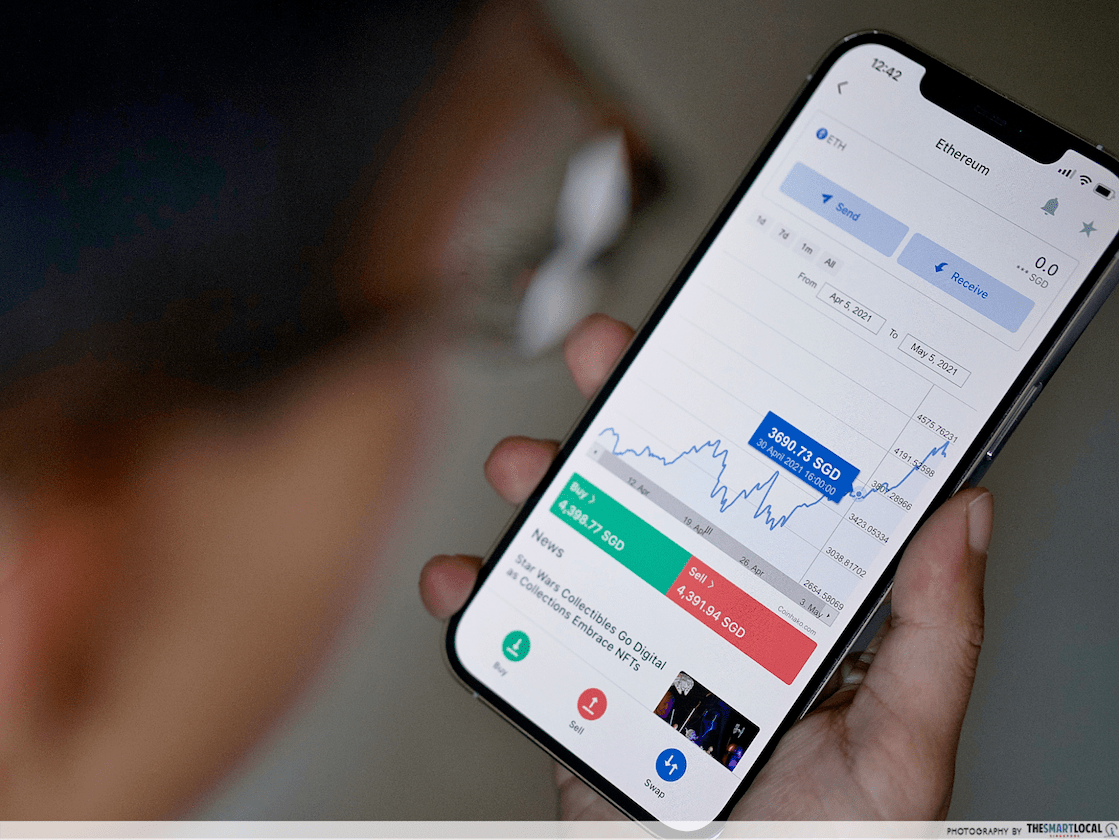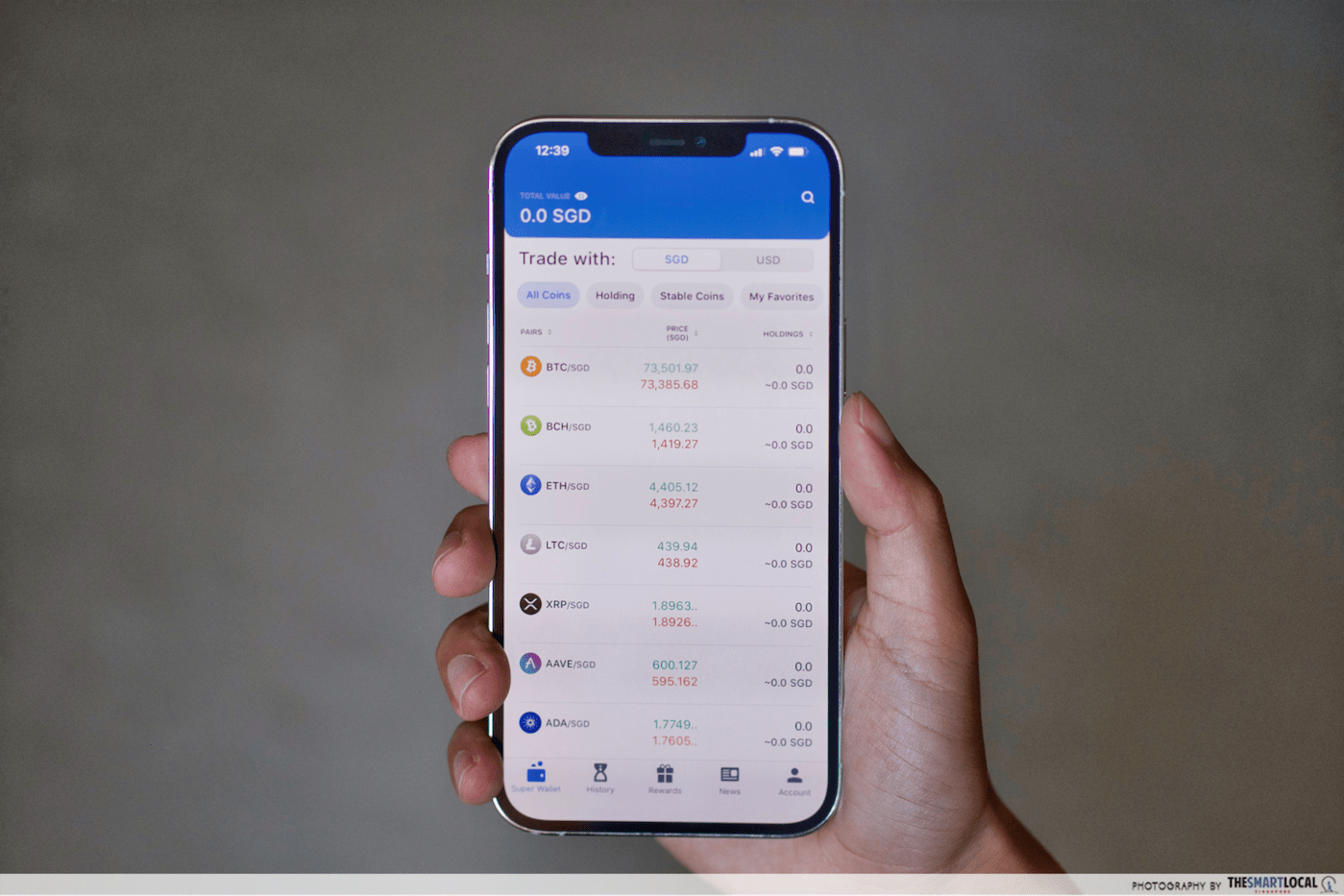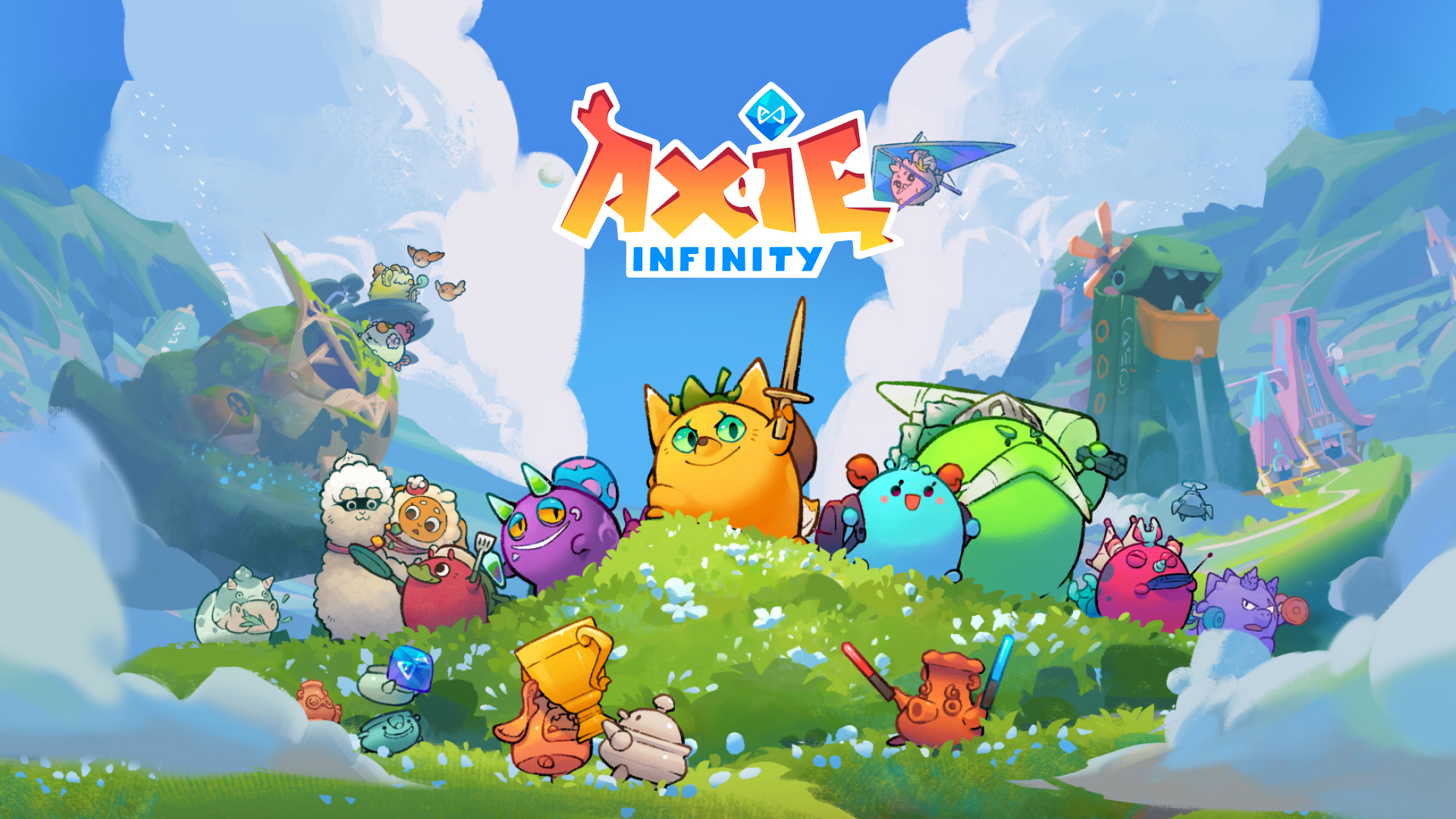Common cryptocurrency terms
We’re deep into the 2020s, and yet some of us still have blank faces when it comes to the whole “crypto thing”. All the crypto ads on YouTube make it look like it’s still a great way to get some cash, but what does it all even mean? We’ve prepared this handy cheat sheet to explain common cryptocurrency terms you should know if you’re thinking of dabbling in crypto.
Table of Contents
- Common cryptocurrency terms
- Can you pay in cryptocurrency in Singapore?
- Is cryptocurrency taxed in Singapore?
- 1. Bitcoin
- 2. Altcoin
- 3. Blockchain
- 4. Bear/Bull/Crab market
- 5. Coin/Token
- 6. DeFi
- 7. Ethereum
- 8. Fiat
- 9. Gas fees
- 10. HODL
- 11. Layer 1/Layer 2
- 12. Memecoin
- 13. Mining
- 14. NFTs
- 15. ‘Not Your Keys, Not Your Crypto’
- 16. Pump & dump
- 17. Rug pull
- 18. Staking
- 19. To the moon
- 20. Wallet
- 21. Stablecoins
- 22. GameFi
- 23. Web3
- 24. Metaverse
Can you pay in cryptocurrency in Singapore?
All this crypto talk but what can you even buy with it? Well, in Singapore, a lot, actually. Singapore was called one of the most “crypto-friendly nations” by CNBC, and with companies here allowing more crypto in transactions, this proves right.
You can use crypto to top up your GrabPay Wallet, with 5 different cryptocurrencies: Bitcoin, Ether, XSGD, USDC, and USDT. This essentially means that you could pay for anything that uses GrabPay with crypto.
Aside from that, luxury stores like Gucci and Charles & Keith have allowed for crypto payments for some time, as well as some restaurants like Joo Bar.
But just a note: cryptocurrency is not considered legal tender in Singapore, although it is treated as an alternative form of payment. This basically means you can use it to buy and sell, but it cannot be used to settle debts and financial obligations.
Is cryptocurrency taxed in Singapore?
Crypto bros can rejoice as Singapore doesn’t have capital taxes for individual cryptocurrency investors. So for the most part, you can rake in the dough without having to declare your earnings in your income tax.
However, if you are a small investing company or a large firm, you would have to declare any profits made from investing in cryptocurrency in your corporate income tax.
Crypto transactions are exempt from GST too, so if you’re buying or selling products using tokens, you won’t have to worry about the GST hike.
1. Bitcoin

This is the cryptocurrency token that kickstarted the growth of crypto. Bitcoin was introduced on 3rd January 2009, based on a whitepaper published by the mysterious Satoshi Nakamoto. This was apparently done as a reaction to the actions of American financial institutions that caused the global financial crisis of 2008. And no, we still don’t know who Nakamoto is.
Since its inception, Bitcoin has been the leading cryptocurrency in terms of price and market cap. Altcoins largely track Bitcoin’s price movement, leading many analysts to use Bitcoin as the benchmark for the entire crypto market.
2. Altcoin
“Altcoin” is a catch-all term used to describe any cryptocurrency that isn’t Bitcoin. This distinction is important because Bitcoin is the first cryptocurrency ever created, and all other cryptos came afterwards.
Some altcoins are based on Bitcoin, whereas others are completely original. Certain altcoins are highly popular and well-known; some such examples include Ethereum, Cardano, and Solana.
3. Blockchain
A blockchain is the technology underlying a cryptocurrency. It looks like how it sounds – blocks of data chained to one another in sequence, forming a digital ledger.
Blockchains are used for storing financial transactions and other forms of data in a transparent and secure way, while guaranteeing the fidelity of the data recorded within.
Before a new block of data can be added, it has to be verified by network participants, who each hold a copy of the blockchain. Any data found to be invalid is discarded, ensuring only legitimate transactions are added to the blockchain.
Additionally, data recorded on the blockchain cannot be changed, preventing illegal alterations to sensitive or important records.
Finally, the transactions recorded on blockchains are open. Anyone can view them using a compatible blockchain viewer or browser.
4. Bear/Bull/Crab market
Reddit-speak that describes the 3 possible directions the crypto market can take – rising, falling, or sideways.
A bear market means prices are falling, while a bull market means prices are going up. When prices make no meaningful headway in either direction over a period of time – hence, moving sideways – Redditors call it a crab market.
Due to the relatively high volatility in the crypto market, and perhaps also the impatient nature of many crypto investors, these terms are bandied about with a far higher frequency than in traditional markets.
5. Coin/Token

While “coin” and “token” are used interchangeably when talking about cryptocurrencies, there are technical differences between them.
The main difference is this: Crypto coins have their own blockchains, while crypto tokens are built on an existing blockchain.
For example, ETH (Ether), being native to the Ethereum blockchain, is a coin. Meanwhile, BAT (Basic Attention Token) operates on the Ethereum blockchain. It is not native, and hence, is a token.
Coins and tokens are also used in different ways and have different functions. For example, coins may be used for payment, and to store value. Tokens, meanwhile, represent assets, deeds, or voting rights.
However, for the average crypto user, coins and tokens may be considered one and the same. We included this entry so you can show off. You’re welcome.
6. DeFi
DeFi – short for DeCentralised Finance – refers to the advent of innovative financial services and bank-like platforms for crypto investors.
Some of the services offered by DeFi include loans, lending, trading of assets and derivatives, and earning interest or yield on crypto holdings.
DeFi is powered by smart contracts, allowing complex transactions to be performed faster, and without the need for paperwork and costly middlemen.
7. Ethereum

Ethereum is the blockchain of Ether (ETH), the second largest cryptocurrency by market cap. It is sometimes referred to as the digital silver to Bitcoin’s digital gold.
The Ethereum network has the largest number of developers by far. A recent Electric Capital Developer Report counted over 4,000 monthly active developers working on Ethereum, compared to around 680 on Bitcoin.
The Ethereum blockchain is the de facto home for the majority of decentralised apps, hosting the lion’s share of over 3,000 projects.
8. Fiat

Fiat currency refers to the paper notes and metal coins used as money in the physical world. When you withdraw the balance in your traditional bank account, you receive fiat currency.
The term “fiat” means “by decree”, making fiat money currency that is backed only by the guarantee of the issuing body, commonly a nation’s central bank.
You’ll run into this term a lot when investing in crypto, due to the need to differentiate between things like your crypto wallet and your fiat wallet.
9. Gas fees
When you carry out a transaction on a blockchain, you’ll need to pay a gas fee. The amount varies according to blockchain, and can also be affected by factors such as network traffic.
Due to its massive popularity, Ethereum is often criticised for having high gas fees, in some cases, even outstripping the value of the transaction.
When carrying out a crypto transaction, it is a good idea to pay attention to the gas fees. This is because gas fees tend to rise as network usage increases, so delaying your transaction until the network is less congested can result in lower gas fees, helping you save money.
10. HODL

Image adapted from: u/valkerner1 via Reddit
Derived from a now-legendary Reddit post in which a user drunkenly misspelt “hold” in an amusing rant, declaring that he is HODLING (holding) his tokens instead of attempting to trade them.
To HODL is to keep your tokens in your portfolio, and is an often-repeated rallying cry during market downturns. Those who HODL are known as HODLers.
The term’s secondary meaning is as an abbreviation for Hold On for Dear Life. This also works, given how volatile crypto can get.
11. Layer 1/Layer 2
You might have come across some YouTuber or TikToker breathlessly gushing about “Layer 1” this and “Layer 2” that, and how they’re going to change absolutely everything as we know it. But actually, it’s not really that relevant to the average crypto investor.
These are simply technical terms used to describe blockchain architecture, with Layer 1 denoting the blockchain itself, and Layer 2 referring to the technology or code that sits atop Layer 1.
There are some crypto fanboys who like to screech about the (supposed) superiority of their chosen crypto because it’s a “Layer 2 solution!!!!1111”, but in reality, it’s all a bit of a storm in a teacup.
12. Memecoin

Image credit: Shiba Token
A memecoin is an altcoin that has no purpose, use case or real world application. They are created solely for laughs, and their price action is driven purely by The Greater Fool Theory. Dogecoin, Shib, and Squid are some of the most well-known examples of memecoins.
As memecoins have no inherent value, they are often fingered by crypto critics as examples of why cryptocurrency should be avoided.
Despite this, memecoins have made their way into the public consciousness, largely because of the headlines they inspire.
13. Mining
Mining is the process which brings new crypto coins or tokens into existence on the blockchain. This is accomplished by solving a series of complicated mathematical problems using a specialised computer.
The miner that manages to get the correct answer is rewarded with a predetermined number of coins. The miner then sells their coins for profit and to cover the costs of mining.
Mining can also refer to Liquidity Mining, a popular activity in DeFi. A Liquidity Miner deposits cryptocurrency into a Liquidity Pool to facilitate trades. In return, they receive a reward – commonly some crypto tokens, plus a portion of the trading fee collected by the Liquidity Pool.
14. NFTs

This digital artwork by Beeple was sold for over USD69 million
Image credit: Christie’s
NFTs, or Non-Fungible Tokens, are a class of digital assets that exist on the blockchain.
Fungibility is the property of being interchangeable – for example, a $2 note is interchangeable with another $2 note. Hence, all $2 notes are fungible.
Non-Fungible Tokens, then, cannot be interchanged with each other. Each NFT is a unique digital asset, and is verified by the blockchain to be so.
As such, NFTs are ideal for proving ownership, even for things that can be easily copied, such as a jpeg, a digital video clip, or a piece of gear or costume in an online game.
NFTs exploded in popularity in 2021, and continues to be a highly speculative area of cryptocurrency. However, NFTs hold promising potential to fight counterfeiting and scalping in the real world.
15. ‘Not Your Keys, Not Your Crypto’
Another common refrain among the crypto community, Not Your Keys, Not Your Crypto is the idea that non-custodial storage is the safest way to store your digital assets. Think of non-custodial storage as you, and only you, having the only key to a room where you keep your stuff.
In contrast, using a custodial storage method, such as a web-based exchange wallet, requires sharing control of your private keys. In other words, you and your mum both have keys to your storage room. This increases your risk of losing your tokens if the wallet provider gets hacked.
Crypto enthusiasts discussing token safety utter this phrase with such frequency that one might be forgiven for thinking it to be some sort of passphrase to some underground techno cult or something.
16. Pump & dump
A pump and dump is a common type of crypto scam, where the creator of the token drives up the token’s price by fostering hype and mania.
This is largely accomplished by paying influencers and celebrities to promote the token to their followers. As more people purchase the crypto, the price goes up, enriching the token creator who is holding the majority of the tokens. This is the pump part of the scheme.
Here comes the dump. When the price hits a sufficiently high point, the creator sells their entire stash, cashes out their gains, and disappears. With a massive amount of tokens suddenly flooding the market, the price of the crypto crashes, if not to zero, then close enough.

The people who gave in to FOMO and bought the coins are now left holding a bag of worthless tokens, with virtually no chance to get their money back.
A notorious crypto Pump and Dump scam in recent memory is Squid Token, which relied on the popularity of the smash Korean hit Squid Game to defraud victims of millions of dollars.
While Pump and Dumps are common in cryptocurrency, they are hardly unique to the sector. These scams can be found in the stock market too.
17. Rug pull
Many DeFi services require participants to deposit their cryptocurrencies into a platform. Well, there’s a scam targeting those too.
A rug pull is another common crypto scam where crooks drain off all investor deposits and run away with the funds. This can be perpetuated by the creators who hold control over the afflicted project, or by hackers who find and exploit vulnerabilities in the project’s code.
Projects that suffer Rug Pulls are also likely to see the price of their token crash as confidence in the project plummets. This causes more investors to suffer losses.
18. Staking

Staking your cryptocurrency means depositing your coins or token to secure and validate the network, in exchange for interest earned, exclusive benefits or other rewards. Your rewards or benefits will continue until you withdraw your stake.
Crypto staking is employed by Proof-of-Stake blockchains, which allow token holders to pledge their coins in order to verify transactions. These validators receive more tokens when a block of transactions are correctly verified and added to the blockchain.
Perhaps the most well-known Proof-of-Stake blockchain is Cardano.
On the other hand, blockchains like Bitcoin and Ethereum use Proof-of-Work as a consensus mechanism, which relies on computing power to solve mathematical equations in order to verify transactions.
19. To the moon
A much-derided rallying cry expressing a fervent belief that a certain crypto will see a dramatic increase in price, blasting off “to the moon”.
This belief is, of course, pretty wild, as the chances of a random crypto suddenly shooting up in price for no reason is virtually non-existent – unless it’s a Pump and Dump, see above.
Nevertheless, this doesn’t stop crypto fanboys from spamming this phrase all over their favourite echo chambers, earning them the nickname “Moonboys” and the disdain that comes with it.
20. Wallet

A wallet is used to send, store and receive your crypto coins and tokens. Some wallets offer other capabilities, such as staking your cryptos without first having to transfer them out to another platform.
It is important to know there are 2 types of wallets – hot wallets, and cold wallets – and they differ in terms of security, convenience and usage.
Hot wallets are software wallets that take the form of browser plug-ins on your desktop, apps on your mobile phone, or can be included in your cryptocurrency exchange account.
Because they are online, hot wallets are accessible anytime and anywhere, and are considered more convenient because of this. However, hot wallets are constantly exposed to the threat of hacking, which could result in the loss of your funds.
On the other hand, cold wallets are physical hardware devices that can only be accessed when connected to a computer. When you have finished depositing or withdrawing your crypto, you disconnect the cold wallet for safekeeping. This keeps your digital assets offline and away from online threats.
The disadvantage of cold wallets is that you’ll need to find and plug it in every time you want to make a transaction. Also, a cold wallet is strictly non-custodial, which means losing it or your private keys equals losing your cryptos.
21. Stablecoins
You would think that with all of the big-brain traders, someone would have come up with a form of crypto that isn’t so volatile. Well, you’d be absolutely right. Introducing stablecoins, a type of cryptocurrency that is tied to a real-life currency or commodity, like gold.
These tokens are considerably safer as their value is pegged to the real-life item. Think of it this way, a dollar today is going to be worth a dollar a week from now. Any change in value is extremely gradual and often caused by the natural inflation of the economy.
This means that stablecoins may not be able to earn as much as Bitcoins, but that’s just one of the trade-offs for safety.
22. GameFi
All the towers of numbers and computer screens can get boring even for some of the biggest finance junkies. Thankfully, that’s where GameFi or Game Finance comes in. GameFi is a type of DeFi which adds a game-like quality to spark more incentive in trading.
 Image credit: Axie Infinity
Image credit: Axie Infinity
You might already have heard of Axie Infinity, a game similar to Pokémon and Tamagotchi. You have pet-like creatures to take care of and evolve called Axies. There are different add-ons and power-ups that players can win through doing daily quests and winning battles against other players. That’s called P2E or Play 2 Earn.
Some of these items are quite valuable, with players willing to fork out large sums just to have them in their inventory. GameFi allows players to use crypto to safely transfer rare drops and items from one player to another.
So the next time your partner complains about you gaming all day, tell them you’re earning dough for their dream honeymoon.
23. Web3
Imagine a world where your internet experience was controlled by you, and not the government or big giants like Google and Meta. That’s the very idea behind Web3, the supposed next phase of the internet where users will completely own their internet usage.
This means your data would only be accessible by you – whatever shady websites you visit late at night is just between you and your screen. It also means that other websites won’t be able to mine your info to advertise things you’ve been thinking about to you.
It’ll also be easier for web users to create their own sites and domains without a middleman. It could mean that you’ll be able to be paid for content without having to pay for intermediary fees.
Web3 is still only in its early stages and as you can imagine, it isn’t very encouraged by big companies. In time, however, it might give a brand new meaning to what surfing the web means.
24. Metaverse
No no, we’re not talking about the Avengers and other dimensions, the Metaverse is simply a virtual universe where interactions happen through digital avatars. Avatars are virtual versions of us, like Sims, that troop through the recreation.
But this is no game, much like Axie Infinity, the Metaverse can be used to make monetary transactions using cryptocurrency. Simply put, the Metaverse is an extension of Web3.
Some countries like Tuvalu, which are suffering through the effects of climate change, have aimed to move to Web3 as a digital nation, where tourists can pay for metaversal experiences. This would allow elements of their culture and what their country looks like to be preserved forever.
Cryptocurrency terms to know
These common crypto terms are just the tip of the very large and at-times confusing iceberg that is cryptocurrency. Hopefully, this list has helped to give you some clarity while providing some starting points for those looking to delve further.
There are lots more to learn and decipher in cryptocurrency, but the chances of being rewarded for putting in the effort grow day by day.
Read more on finance here:
Cover image adapted from: Shiba & Wikipedia
Originally published on 15th February 2022. Last updated by Ezekiel Sen on 28th March 2024.
